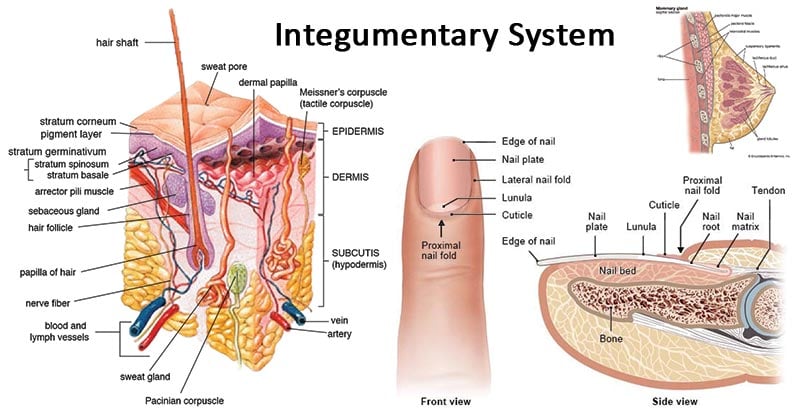
The integumentary system is one of the most complex and versatile systems in the human body, serving a multitude of functions that are crucial for survival and overall well-being. This remarkable system primarily consists of the skin, hair, nails, and various associated glands. Its multifaceted roles encompass protection, regulation, sensation, and even aesthetics. In this comprehensive article, we will delve into the primary function of the integumentary system and explore the various ways in which it contributes to our health and daily lives.
The Anatomy of the Integumentary System
Before we delve into its primary function, let’s briefly understand the components of the integumentary system:
- Skin: The skin is the largest organ of the human body, covering an average of about 20 square feet in adults. It consists of three main layers: the epidermis, the dermis, and the subcutaneous tissue (hypodermis). Each layer plays a unique role in maintaining the skin’s functions.
- Hair: Hair is a filamentous structure that grows from hair follicles embedded in the skin. It is composed primarily of a protein called keratin. Hair serves various functions, including insulation, protection, and sensory perception.
- Nails: Nails are hard, flat plates composed of keratin. They protect the tips of the fingers and toes, provide support for delicate fingertip tissues, and assist in fine motor functions.
- Glands: There are several types of glands associated with the integumentary system, including sweat glands (eccrine and apocrine), sebaceous glands, and mammary glands. These glands play a significant role in maintaining skin health and regulating body temperature.
The Primary Function: Protection
The primary function of the integumentary system is protection, and it does so in a multitude of ways:
1. Barrier Function
The skin’s outermost layer, the epidermis, acts as a physical barrier that prevents harmful microorganisms, chemicals, and foreign substances from entering the body. It keeps pathogens like bacteria and viruses at bay, helping to fend off infections.
2. UV Radiation Protection
Melanin, a pigment found in the epidermis, provides protection against harmful ultraviolet (UV) radiation from the sun. Melanocytes, specialized skin cells, produce melanin in response to sun exposure, helping to shield the body from UV damage.
3. Mechanical Protection
The integumentary system provides mechanical protection against physical injuries. The skin acts as a cushion against bumps and scrapes, reducing the risk of damage to underlying tissues and organs.
4. Temperature Regulation
The integumentary system plays a critical role in temperature regulation. When the body overheats, sweat glands release sweat onto the skin’s surface. As this sweat evaporates, it cools the body. In colder temperatures, blood vessels in the skin constrict to reduce heat loss.
5. Sensory Perception
The skin is rich in sensory receptors, including those for touch, temperature, and pain. These receptors allow us to perceive and respond to our environment, helping to keep us safe from potential dangers.
6. Immune Defense
Skin is equipped with immune cells that defend against infection. When the skin is breached, these immune cells help to initiate an immune response to combat invading pathogens.
Beyond Protection: Additional Functions
While protection is the primary function of the integumentary system, it serves various secondary functions that contribute to our overall well-being:
1. Excretion
Sweat glands play a role in excreting waste products, such as urea and excess salts, from the body. This aids in maintaining electrolyte balance.
2. Vitamin D Synthesis
When exposed to sunlight, the skin produces vitamin D, an essential nutrient for bone health and overall immunity.
3. Aesthetic and Social Functions
The appearance of our skin, hair, and nails significantly influences our self-esteem and social interactions. The integumentary system plays a role in aesthetics and grooming.
Conclusion
The integumentary system is a remarkable and multifunctional system that serves as the body’s primary defense mechanism. Its primary function of protection encompasses safeguarding the body against external threats, regulating temperature, and providing sensory feedback. Beyond protection, it plays a role in various other physiological processes, making it an indispensable part of our overall health and well-being. Understanding the importance of this complex system highlights the significance of proper skin care and maintenance in maintaining a healthy and thriving body.



